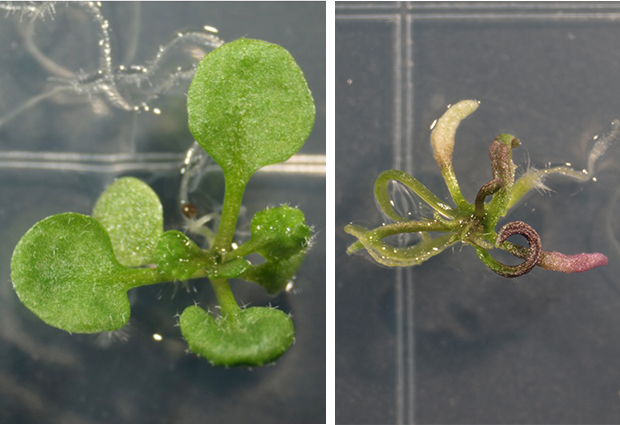In pursuit of flat growth in leaves

If the molecular balance is disturbed, leaves grow stem-like (right), instead of flattening out. PHOTO: Paz Merelo/EMBL
As a leaf develops, its cells create two different tissues, one on each side of the leaf. Scientists knew that only cells in the top side produce proteins called Class III HD-ZIPs. In the bottom layer, these Class IIIs are suppressed by another set of molecules called microRNA165/166. But how are those microRNAs confined to the bottom side?
Marcus Heisler’s labs at EMBL and at the University of Sydney found that the Class IIIs in the top tissues of the leaf act together with some closely related proteins, the Class IIs, to suppress the microRNAs.
When Paz Merelo, a postdoc in Heisler’s lab at EMBL, examined Arabidopsis plants in which these Class IIs were not functioning, the microRNAs were no longer inhibited in the top side of the growing leaves.
So in the absence of Class IIs, the Class IIIs alone aren’t able to counter the microRNAs. The microRNAs can then switch off the Class IIIs on both the bottom and the top of the leaves, and consequently the leaves don’t flatten out, but grow stem-like.
“The activities of the Class III HD-ZIPs and microRNAs somehow have to be perfectly balanced, right from the beginning, to get a nice leaf,” says Heisler. “And that seems unlikely to happen on its own: so what’s maintaining this balance?”
Heisler and colleagues are following up on the work, looking into how the balance between ‘top’ and ‘bottom’ factors is maintained, honing in on exactly how Class IIIs and Class IIs work together, and investigating other molecules that are restricted to only one side of a growing leaf.
The study was a collaboration with Stephan Wenkel’s lab at the University of Copenhagen.
- Full bibliographic informationMerelo et al. Regulation of MIR165/166 by Class II and Class III homeodomain leucine zipper proteins establishes leaf polarity. PNAS Early Edition, to be published the week of 3 October 2016. DOI: 10.1073/pnas.1516110113
For further information, please contact:
Sonia Furtado
+ 49 6221 387 8263
Media Contact
All latest news from the category: Life Sciences and Chemistry
Articles and reports from the Life Sciences and chemistry area deal with applied and basic research into modern biology, chemistry and human medicine.
Valuable information can be found on a range of life sciences fields including bacteriology, biochemistry, bionics, bioinformatics, biophysics, biotechnology, genetics, geobotany, human biology, marine biology, microbiology, molecular biology, cellular biology, zoology, bioinorganic chemistry, microchemistry and environmental chemistry.
Newest articles

Making diamonds at ambient pressure
Scientists develop novel liquid metal alloy system to synthesize diamond under moderate conditions. Did you know that 99% of synthetic diamonds are currently produced using high-pressure and high-temperature (HPHT) methods?[2]…

Eruption of mega-magnetic star lights up nearby galaxy
Thanks to ESA satellites, an international team including UNIGE researchers has detected a giant eruption coming from a magnetar, an extremely magnetic neutron star. While ESA’s satellite INTEGRAL was observing…

Solving the riddle of the sphingolipids in coronary artery disease
Weill Cornell Medicine investigators have uncovered a way to unleash in blood vessels the protective effects of a type of fat-related molecule known as a sphingolipid, suggesting a promising new…





















